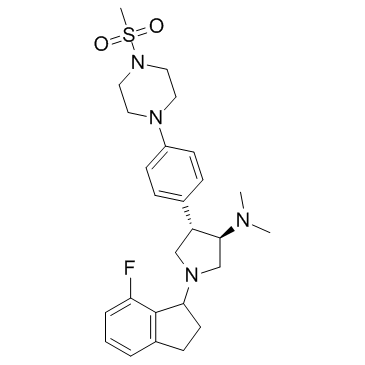A-395 (A395) |
| Catalog No.GC33187 |
A-395(A395)는 18 nM의 IC50으로 삼량체 PRC2 복합체(EZH2-EED-SUZ12)를 강력하게 억제하는 폴리콤 억제 복합체 2(PRC2) 단백질-단백질 상호작용의 길항제입니다.
Products are for research use only. Not for human use. We do not sell to patients.

Cas No.: 2089148-72-9
Sample solution is provided at 25 µL, 10mM.
A-395 is a novel antagonist of Polycomb repressive complex 2 (PRC2) protein-protein interactions that potently inhibits the trimeric PRC2 complex (EZH2-EED-SUZ12) with an IC50 of 18 nM.
The embryonic ectoderm development (EED) protein is an essential subunit of Polycomb repressive complex 2 (PRC2). A-395 antagonizes of the H3K27me3 binding functions of EED. A-395 binds to EED in the H3K27me3-binding pocket, thereby preventing allosteric activation of the catalytic activity of PRC2. A-395 is capable of competing for H3K27me3 peptide binding to EED, with an IC50 of 7 nM. A-395, but not the close chemical analog A-395N, modulates activity of PRC2 in cells by potently reducing the H3K27 methyl mark in a highly selective manner. A-395 treatment inhibits both H3K27me2 and H3K27me3, with IC50 values of 390 nM and 90 nM, respectively. Furthermore, A-395 treatment results in growth inhibition of human tumor cell lines sensitive to SAM-competitive EZH2 inhibitors[1].
The embryonic ectoderm development (EED) protein is an essential subunit of Polycomb repressive complex 2 (PRC2). A-395 antagonizes of the H3K27me3 binding functions of EED. A-395 binds to EED in the H3K27me3-binding pocket, thereby preventing allosteric activation of the catalytic activity of PRC2. A-395 is capable of competing for H3K27me3 peptide binding to EED, with an IC50 of 7 nM. A-395, but not the close chemical analog A-395N, modulates activity of PRC2 in cells by potently reducing the H3K27 methyl mark in a highly selective manner. A-395 treatment inhibits both H3K27me2 and H3K27me3, with IC50 values of 390 nM and 90 nM, respectively. Furthermore, A-395 treatment results in growth inhibition of human tumor cell lines sensitive to SAM-competitive EZH2 inhibitors[1].
[1]. He Y, et al. The EED protein-protein interaction inhibitor A-395 inactivates the PRC2 complex. Nat Chem Biol. 2017 Apr;13(4):389-395.
Average Rating: 5 (Based on Reviews and 19 reference(s) in Google Scholar.)
GLPBIO products are for RESEARCH USE ONLY. Please make sure your review or question is research based.
Required fields are marked with *




















